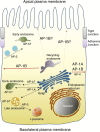The Role of the Clathrin Adaptor AP-1: Polarized Sorting and Beyond
- PMID: 25387275
- PMCID: PMC4289864
- DOI: 10.3390/membranes4040747
The Role of the Clathrin Adaptor AP-1: Polarized Sorting and Beyond
Abstract
The selective transport of proteins or lipids by vesicular transport is a fundamental process supporting cellular physiology. The budding process involves cargo sorting and vesicle formation at the donor membrane and constitutes an important process in vesicular transport. This process is particularly important for the polarized sorting in epithelial cells, in which the cargo molecules need to be selectively sorted and transported to two distinct destinations, the apical or basolateral plasma membrane. Adaptor protein (AP)-1, a member of the AP complex family, which includes the ubiquitously expressed AP-1A and the epithelium-specific AP-1B, regulates polarized sorting at the trans-Golgi network and/or at the recycling endosomes. A growing body of evidence, especially from studies using model organisms and animals, demonstrates that the AP-1-mediated polarized sorting supports the development and physiology of multi-cellular units as functional organs and tissues (e.g., cell fate determination, inflammation and gut immune homeostasis). Furthermore, a possible involvement of AP-1B in the pathogenesis of human diseases, such as Crohn's disease and cancer, is now becoming evident. These data highlight the significant contribution of AP-1 complexes to the physiology of multicellular organisms, as master regulators of polarized sorting in epithelial cells.
Figures


References
-
- Palade G. Intracellular aspects of the process of protein synthesis. Science. 1975;189:347–358. - PubMed
-
- Randy W. Schekman—Nobel Lecture: Genetic and Biochemical Dissection of the Secretory Pathway. [(accessed on 7 September 2014)]. Available online: http://www.nobelprize.org/nobel_prizes/medicine/laureates/2013/schekman-....
-
- Tsukita S., Furuse M., Itoh M. Multifunctional strands in tight junctions. Nat. Rev. Mol. Cell Biol. 2001;2:285–293. - PubMed
Publication types
LinkOut - more resources
Full Text Sources
Other Literature Sources

